When a hailstorm hits, your roof takes the brunt of nature’s fury, shielding your home from harm. But have you wondered how much damage it endures in the process? Hailstorms can wreak havoc on roofing materials, leading to costly repairs if not addressed promptly. This article dives deep into what you need to know about hail damage roof repair. From understanding the signs of damage to choosing the right contractor and taking preventative measures, we’ve got you covered.
Continue readingCategory Archives: Blog
The Ultimate Guide to Asphalt Roofing in London, Ontario
If you’re a homeowner in London, Ontario, choosing the right roofing material is crucial to protecting your home against the region’s unique climate. Asphalt roofing has long been a popular choice for its affordability, durability, and versatility. Whether you’re upgrading your current roof or building a new home, understanding the advantages and considerations of asphalt roofing can help you make an informed decision. From benefits and installation to maintenance tips, this article dives into everything London homeowners should know about asphalt roofing.
Continue readingPreparing for Roof Leak Repairs: Everything You Need to Know
Roof leaks can be both an inconvenience and a major source of worry for homeowners. Left unchecked, they can lead to costly damages, not just to your roof but to the structural integrity of your home. Water damage can result in ruined ceilings, mold growth, and deterioration of walls and insulation, creating a cascade of problems over time. Addressing roof leaks promptly is not just a matter of convenience; it’s a critical step in safeguarding your home and preventing expensive repairs down the line.
This guide will walk you through identifying roof leaks, equipping yourself with the right tools, making temporary repairs, and understanding when to call in the pros for long-term solutions. Lastly, you’ll learn how preventative maintenance can save your roof from future problems.
Continue readingHow Long Should an Asphalt Shingle Roof Last?
When investing in roofing material, durability is top of mind for homeowners and property managers alike. Asphalt shingles are a popular roofing choice due to their affordability, versatility, and ease of installation. But how long can you expect them to last? While the average lifespan of an asphalt shingle roof is approximately 20-30 years, a multitude of factors can influence this range. This comprehensive guide will explore what affects asphalt shingle longevity, the different types of shingles and their expected lifespans, signs of wear and tear, and tips to extend your roof’s life.
Factors Affecting Asphalt Shingle Roof Lifespan

Several variables affect the lifespan of your roof, starting from the type of shingles you select to the environmental conditions they endure. One major factor is climate. Constant exposure to sun, rain, snow, and wind can significantly wear down a roof. For example, UV rays from prolonged sunlight can weaken the integrity of shingles, while heavy storms cause granule loss or even dislodge shingles altogether. Freezing and thawing cycles in colder climates can also expand and contract the shingles, leading to cracks over time.
Another important determinant is the quality of installation. Even the most durable shingles will fail prematurely without proper installation techniques. Effective ventilation and adequate underlayment prevent structural damage, moisture retention, and heat buildup, all of which could shorten your roof’s lifespan. Always hire experienced and certified roofers to ensure optimal performance.
Finally, maintenance plays a crucial role. Neglecting minor repairs can lead to major issues, such as leaks or rot, that compromise the overall structure. Simple preventive measures, such as cleaning debris from gutters or inspecting for damage after storms, can make a marked difference. While environmental factors may be out of your control, proper installation and consistent maintenance give your roof the best chance at hitting or even exceeding its expected longevity.
Types of Asphalt Shingles and Their Expected Lifespans
The type of asphalt shingles you choose will largely dictate how long your roof lasts. There are three primary categories of asphalt shingles, with each offering distinct lifespans and performance benefits.
Standard asphalt shingles, also known as three-tab shingles, are the most common and economical type. These shingles are lightweight and cost-effective but generally have the shortest lifespan, ranging between 15 and 20 years. Their thinner construction makes them suitable for moderate climates, though they may struggle in areas prone to severe weather.
Architectural shingles, also called dimensional shingles, offer a step up in both aesthetic appeal and durability. Their layered design gives them a more textured, three-dimensional appearance that mimics more expensive roofing materials like slate or cedar. With proper installation and maintenance, architectural shingles can last 25 to 30 years or more.
Lastly, there are premium asphalt shingles, which represent the pinnacle of quality in the asphalt category. These shingles are thicker, heavier, and better equipped to withstand extreme weather. Premium shingles often come with extended warranties and can last 30 to 50 years, making them an ideal choice for those seeking longevity and durability.
Choosing the right type of shingle for your needs depends on both your budget and your local climate. While architectural or premium shingles may require a higher upfront investment, their longer lifespans and better performance can save money in the long run by reducing replacement and repair costs.
Signs Your Asphalt Shingle Roof Needs Replacing
Over time, even the most well-maintained roof will begin to show signs of wear. Knowing when to replace your asphalt shingle roof is key to avoiding further damage to your home. One of the clearest warning signs is curling or buckling shingles. These deformations indicate that shingles are no longer tightly sealed, leaving your roof vulnerable to water penetration.
Missing shingles are another red flag. Whether caused by wind or aging adhesive strips, gaps in your roof leave underlying materials exposed to the elements, accelerating deterioration. Similarly, widespread granule loss is a telltale sign of aging shingles. If you notice excessive granules collecting in your gutters or downspouts, it may be time for a replacement.
Leaks and water stains inside your home should never be ignored. Moisture infiltration can lead to mold growth and structural damage, which are far more costly repairs than replacing a roof. Finally, if your roof is older than 20 years, it’s worth having it professionally inspected, even if there are no obvious problems. A proactive assessment can reveal hidden issues and help you plan for a timely replacement instead of dealing with an unexpected failure.
Maintenance Tips to Extend Your Roof’s Life
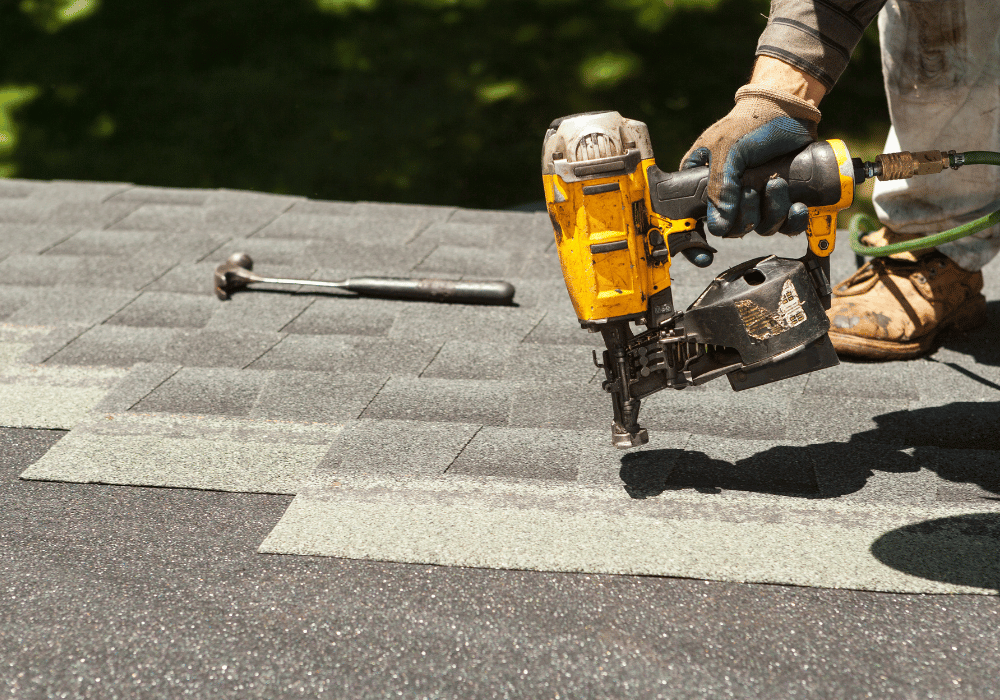
Maintaining an asphalt shingle roof doesn’t have to be an overwhelming task, but it does require consistency. Regular inspections are critical. Aim to check your roof at least twice a year, ideally in the spring and fall, as well as after major storms. Look for damaged, missing, or misaligned shingles, and address issues promptly to prevent more widespread problems.
Keeping your roof clean is another powerful way to extend its lifespan. Debris such as leaves, branches, and moss can trap moisture and lead to rot or algae growth. Use a broom or a low-pressure washer to remove debris periodically, and consider installing zinc or copper strips to prevent algae buildup.
Proper attic ventilation is also crucial for a healthy roof. Without it, heat and moisture can accumulate beneath the shingles, causing them to warp or deteriorate more quickly. Make sure your attic’s ventilation system is functioning properly to keep your roof cool and dry year-round.
Gutters often go overlooked in roof maintenance, but they play a vital role in directing water away from your home. Clogged gutters can cause water to back up onto the roof, leading to leaks or ice dams in colder climates. Clean your gutters regularly, especially during the fall when leaves are more likely to collect.
Lastly, schedule professional maintenance. While many repairs and inspections can be done on your own, hiring a licensed roofing contractor for an annual check-up ensures that no issues go unnoticed. Their trained eye can catch problems that might escape an untrained observer, providing peace of mind and a longer-lasting roof.
Plan for a Roof That Lasts
The lifespan of an asphalt shingle roof depends on many factors, including climate, installation quality, and maintenance habits. By understanding these variables, you can make informed decisions when installing, maintaining, or replacing your roof. Investing in higher-quality shingles, performing regular maintenance, and addressing minor issues promptly can significantly extend your roof’s life.
If you think your roof might be nearing the end of its life, don’t wait until small issues turn into major expenses. Consult with a roofing professional to assess its condition and explore your options for replacement. A proactive approach will ensure that your home stays protected for years to come.
What to Look For When Identifying Roof Wind Damage
Storms can wreak havoc on homes, leaving unseen damage that may worsen over time if left unaddressed. One part of your home that takes the brunt of windy weather is your roof. Identifying wind damage promptly is essential to preventing costly long-term damage. This guide will walk you through key signs of roof wind damage so you can detect issues early and protect your property.
Signs of Missing Shingles
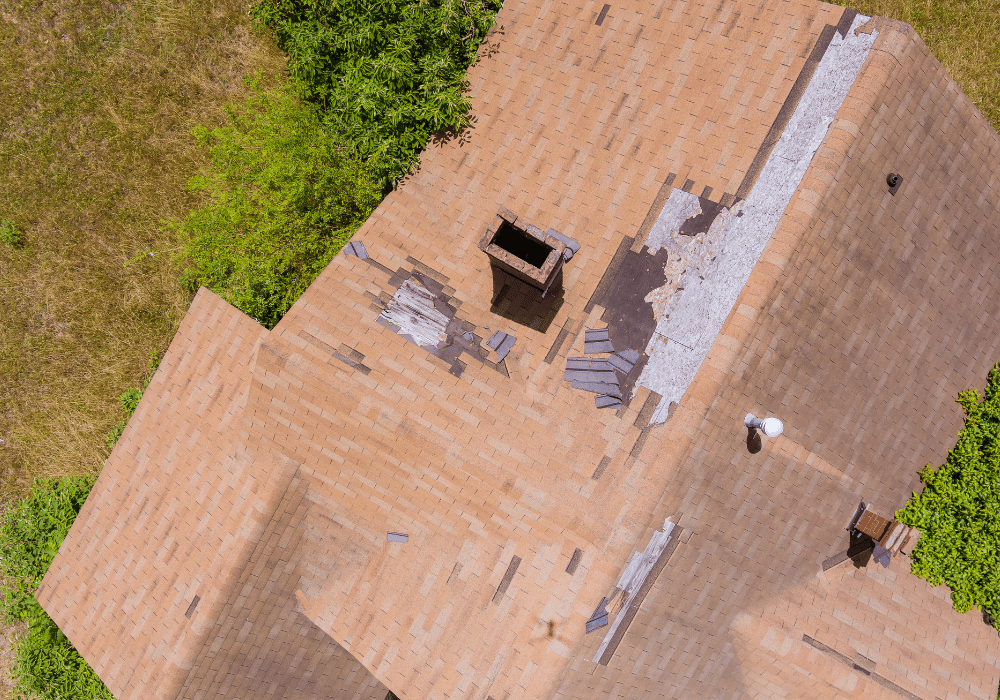
One of the most common indicators of wind damage is missing shingles. High winds can loosen or completely tear shingles off your roof, leaving vulnerable spots exposed. Here’s how to identify this problem effectively:
- Visual Inspection: Step back and examine your roof from the ground. Do you notice any patches where shingles seem to be missing? Broken patterns or bare roof decking are telltale signs.
- Debris Around the Property: Check for shingles scattered around your yard, gutters, or driveway; these could have been ripped off during the storm.
Missing shingles are more than just an eyesore. They can leave your roof vulnerable to leaks, water damage, and structural issues. Addressing them promptly helps maintain your roof’s integrity and prevents further complications.
Granule Loss
Granules are the tiny, sand-like particles on the surface of asphalt shingles. They protect your roof from UV damage and add an extra layer of waterproofing. Wind and hail can strip these granules, leaving parts of your roof exposed. Here’s what to look for:
- Gutter and Downspout Debris: Granules often wash away into your gutters or land near the base of downspouts after a storm. Take a quick look at these areas for small, dark particles.
- Bald Spots on Shingles: Missing granules can leave your roof shingles looking smooth or “bald” in places. If you can safely get a closer look, examine areas that appear lighter or discoloured for granule loss.
Granule loss compromises the protective capabilities of your shingles. Over time, this deterioration can lead to increased wear, reduced energy efficiency, and higher susceptibility to leaks.
Bent or Damaged Flashing
Flashing refers to the metal pieces installed around chimneys, skylights, vents, and other roof edges to divert water away. When winds get intense, they can loosen, bend, or damage these crucial components. Here’s how to spot flashing damage:
- Warps or Bends: Check for any parts of your roof where the metal appears warped, bent, or lifted.
- Missing Seals: Flashing often works hand-in-hand with caulking or seals. Spot any cracks or missing caulk around flashing, as these gaps can lead to leaks.
- Rust or Corrosion: Strong winds sometimes fast-track exposure to moisture, leading to signs of rust.
Damaged flashing compromises your roof’s ability to direct water away, increasing the risk of water infiltration and costly repairs.
Interior Leaks
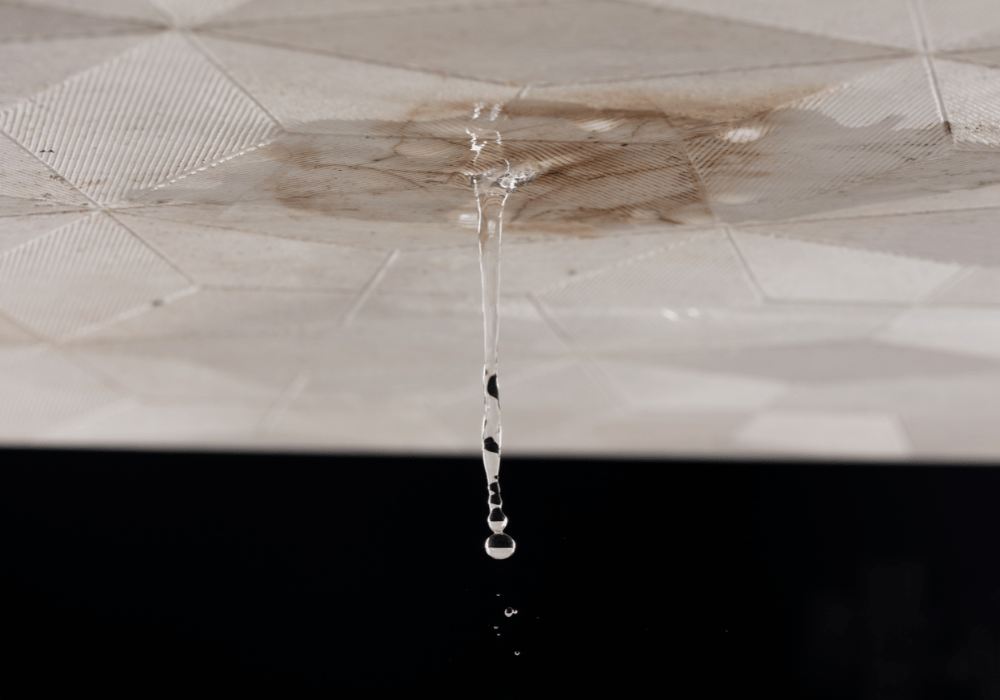
Not all signs of roof wind damage will be visible from the outside. If your roof has suffered structural damage, it may manifest in subtle ways inside your home. Look out for these interior clues:
- Water Stains: Yellow or brown rings on ceilings or walls are clear signs of water damage. These stains are often caused by leaks originating in your roof.
- Dripping Water: If you notice active drips during or after a storm, it’s time to inspect the roof immediately.
- Peeling Paint or Wallpaper: Excess moisture trapped in walls due to leaks can cause paint or wallpaper to bubble, crack, or peel away.
Interior leaks indicate that the roof’s protective barrier has been breached. Neglecting these signs can lead to widespread mould damage, rot, and weakened structural elements.
While you can address minor signs of roof damage yourself, significant issues caused by wind damage require expert attention. Climbing onto a roof can be both dangerous and ineffective for untrained individuals, so hiring a professional roofing contractor is always a smart choice.
A certified inspector will provide a thorough evaluation and recommend tailored solutions to keep your roof in peak condition. They can also help document damage for insurance purposes, ensuring you’re fully supported in the event of a claim.
How Roof Insurance Claims Work: A Step-by-Step Guide for Homeowners
Dealing with roof damage is never a pleasant experience. If you’ve recently faced a storm, fallen debris, or an unforeseen accident causing damage to your roof, one thing is likely on your mind: your insurance claim. Navigating the process of roof insurance claims may seem overwhelming, but understanding the steps involved can ease stress and ensure you’re fairly compensated.
This guide breaks down the process into actionable steps to help homeowners like you successfully handle roof insurance claims. Here’s what you need to know.
Continue readingWhat to Expect During a Roof Installation
A new roof installation is a significant investment that not only enhances the functionality of your home but also contributes to its overall aesthetic and curb appeal. Understanding the process and knowing what to expect during a roof installation can ease your worries and help you prepare for this major project. From the initial preparations to the final inspection, this blog will outline everything you need to know to make the process seamless and stress-free.
Initial Consultation and Estimate
Before starting a roof installation, you’ll typically have an initial consultation with a roofing contractor. During this process, the contractor will inspect your roof to evaluate its condition and determine if a full replacement is necessary. They’ll review material options, offer tailored recommendations based on your budget, and address any specific concerns you may have. Following the consultation, you’ll receive a detailed estimate outlining the project’s costs, including labor, materials, and any additional fees. Carefully reviewing this proposal ensures you fully understand the scope of work and associated expenses.
Scheduling and Preparation
Once you’ve approved the estimate, the next step is scheduling your roof installation. Proper preparation is essential to ensure the process goes smoothly. A reliable roofing contractor will provide a clear timeline, including when materials will be delivered and when work will begin. At this stage, it’s important to prepare your home as well. This may involve clearing your driveway for dumpster placement, moving outdoor furniture or plants to prevent damage, and letting neighbors know about potential noise or disruptions.
Inside your home, take precautions by removing fragile items or securing anything that could be affected by vibrations during the roof removal and installation. While contractors will take measures to protect your property, a little extra preparation on your part can significantly reduce potential risks and ensure a hassle-free experience.
Delivery of Materials
Roofing materials like shingles, underlayment, nails, and flashing are typically delivered one to two days before installation begins, depending on the company. These items are often stored near your property, such as on your driveway or in a designated area. To avoid any inconvenience, it’s important to coordinate with your contractor and confirm where the materials will be placed, particularly if you have concerns about space or accessibility.
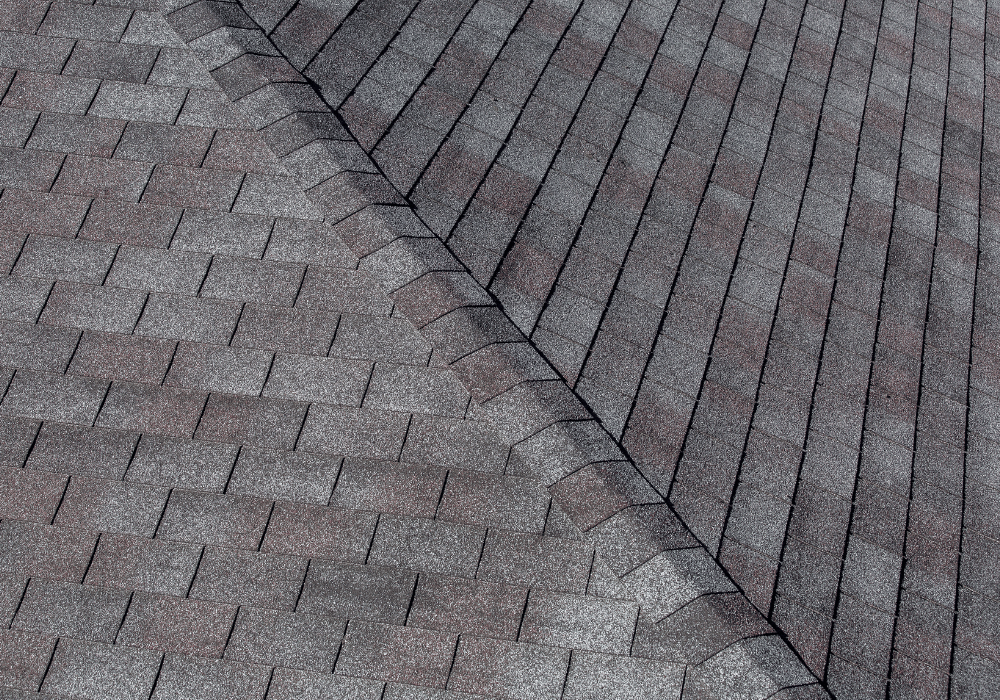
The Day of Installation
1. Setting Up the Site
On the day of installation, the roofing crew will typically arrive early to set up the worksite. This includes laying tarps and coverings to protect your landscaping and other parts of your home from debris. Safety measures will also be implemented to ensure the crew and your property are secure throughout the project.
2. Removing the Old Roof
The first major step is tearing off the old roofing materials. This process can be noisy and involves removing shingles, nails, underlayment, and other components of your existing roof. Debris is collected and placed into a dumpster or truck as the team works to ensure a clean job site. If there’s any pre-existing damage to the roof deck, such as rot or mold, this may also be addressed at this stage.
3. Inspecting the Roof Deck
Before installing the new roof, the roofing crew will inspect the roof deck to ensure it’s structurally sound. Any compromised areas will be repaired or replaced to provide a stable foundation for the new roofing materials. This step is crucial to prevent future issues and ensure the longevity of your new roof.
4. Installing the Underlayment and Roofing Components
Once the roof deck is prepared, the underlayment is installed. This layer provides an additional waterproof barrier to protect your home from leaks. Other important components, like flashing around chimneys, vents, and skylights, will also be installed to ensure maximum protection against water intrusion. Depending on your roofing material, additional layers or systems might be added before the final layer is applied.
5. Installing the New Roofing Material
This is the most visually significant step of the process, as your chosen roofing material—whether it’s asphalt shingles, metal panels, slate, or another option—is installed. The team will work systematically to ensure proper placement, alignment, and secure fastening of the materials to create a durable and beautiful roof.
Mid-Installation Challenges
Even with the best planning, roofing projects can sometimes encounter unexpected challenges. Hidden issues like rotted wood or pest infestations in the roof deck may come to light, sudden weather changes could cause delays, or material shortages might disrupt the schedule. A trustworthy roofing contractor will address these hurdles promptly, keeping you informed and offering practical solutions to ensure the project stays on track.
Cleanup and Final Inspection
Once the roof installation is complete, the crew will thoroughly clean the worksite. This includes removing tarps, collecting debris, and using tools like magnetic rollers to pick up stray nails from around your property. A clean site not only shows professionalism but also ensures your safety.
After cleanup, the contractor will perform a final inspection of the roof to ensure everything was installed correctly and meets quality standards. They’ll check for proper sealing, alignment of materials, and overall workmanship. Some companies also offer warranties on their work, giving you extra peace of mind.
Post-Installation Steps
With a new roof installed, there are a few steps to take after the project is complete. First, review the work with your contractor and make sure you’re satisfied with the results. If you notice any issues during the inspection, communicate them immediately so they can be addressed before the final sign-off.
You should also keep all documentation related to the project, including your contract, warranty information, and any maintenance recommendations from your contractor. Regular upkeep will help you maintain your new roof and extend its lifespan.
How to Minimize Disruption
Roof installations can be noisy and disruptive, but there are ways to reduce their impact. If you work from home or have young children, consider arranging alternative accommodations during the loudest phases, such as tear-offs or material installation. To keep pets calm and comfortable, secure them indoors or take them to a quieter location to minimize anxiety from the noise.
Maintaining clear communication with your contractors can also make a significant difference. Reputable professionals who value transparency and customer satisfaction will keep you informed, helping you anticipate disruptions and plan accordingly. With the right approach, you can navigate the process with minimal inconvenience.
Why Choose a Professional Roofing Company?
The roof is one of the most vital parts of your home, and its installation is best left to the experts. Professional roofing contractors bring a wealth of experience, specialized tools, and high-quality materials to ensure your roof is not only visually appealing but also built to withstand the test of time. By following industry best practices and strict safety standards, they reduce risks to both your property and themselves, delivering a reliable and durable result you can trust.
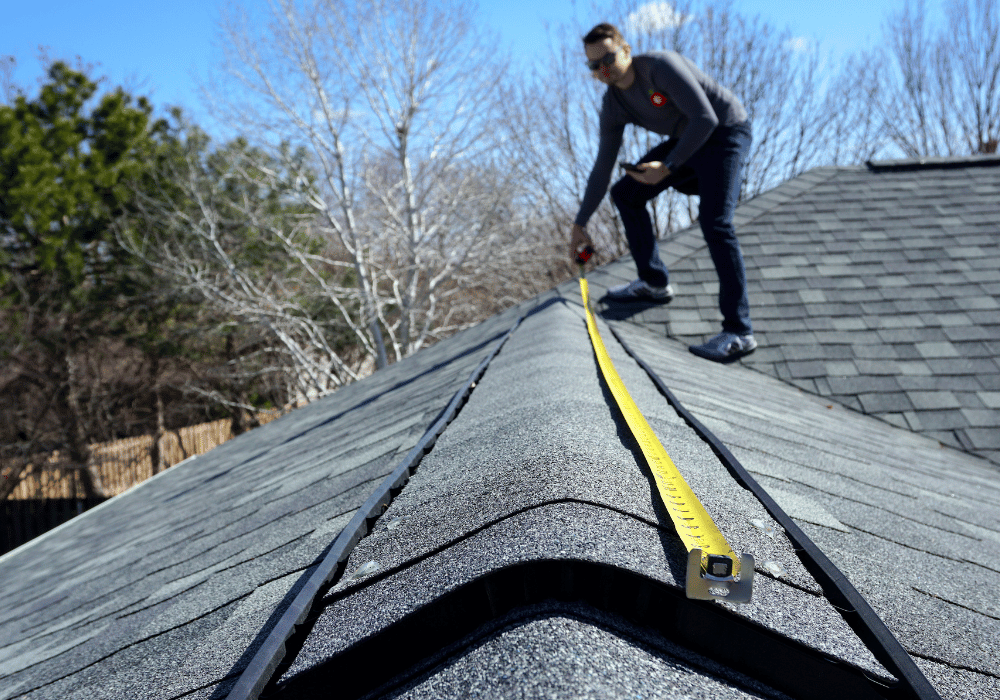
Choosing the right roofing company is essential. Look for a licensed, insured contractor with strong reviews and a proven history of quality work. A dependable roofer will provide clear communication, realistic timelines, and a thorough understanding of your roof’s unique requirements. For expert roof installation in London, Ontario, Shockwave Roofing is your trusted partner. We deliver comprehensive roofing solutions for both residential and commercial properties, ensuring top-notch results every time.
How to Extend the Life of Your Roof
Your roof is a vital part of your home, shielding you and your belongings from the weather. Like any key feature of your house, it requires regular care and maintenance to stay in top condition. Proper upkeep not only extends your roof’s lifespan but also saves you money over time while keeping your home safe and comfortable. To help you maximize your roof’s durability, here are some essential tips and strategies.
Regular Inspections are Key
One of the easiest and most effective ways to extend the lifespan of your roof is to conduct regular inspections. Ideally, you should inspect your roof at least twice a year—once in the spring and again in the fall. During these inspections, look for signs of damage, such as cracked or missing shingles, damaged flashing, or debris buildup. Catching small issues early can prevent them from escalating into major, costly problems.
For homeowners who are uncomfortable inspecting their own roof, hiring a professional roofing contractor to perform an inspection is a wise investment. Professionals can spot subtle signs of wear and tear that might go unnoticed by an untrained eye.
Keep Your Gutters Clean
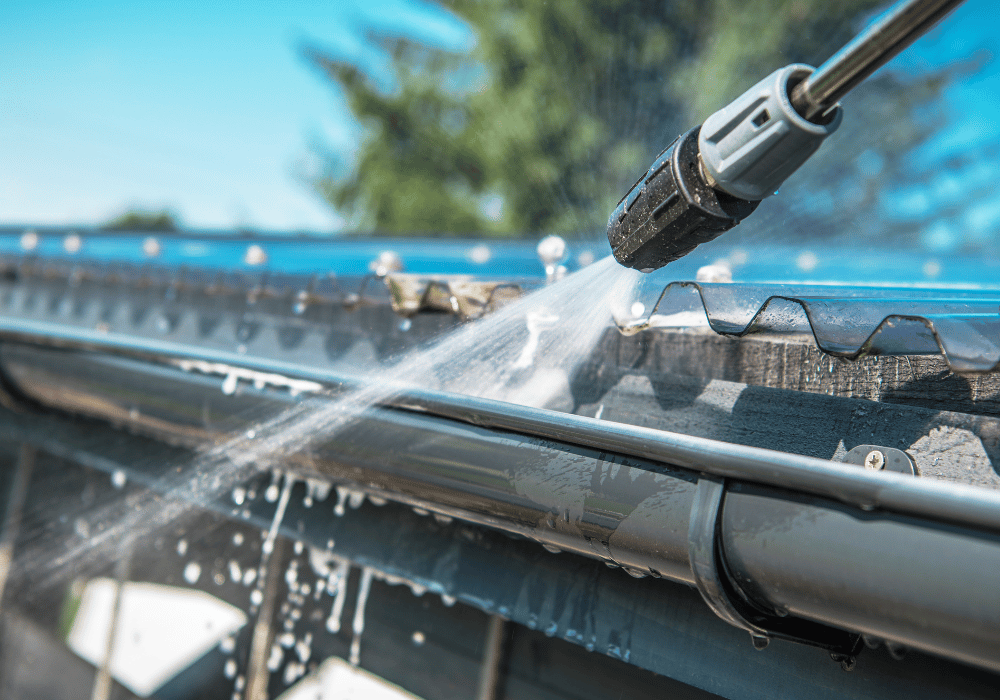
Clogged gutters can cause water to back up onto your roof, leading to water damage, mold growth, and even structural issues. It’s essential to clean your gutters regularly, especially after heavy storms or when leaves and debris accumulate during the fall. Make sure water is flowing freely through the downspouts and away from your home’s foundation.
Installing gutter guards can be a helpful solution to minimize debris buildup and reduce the frequency of cleaning. Properly functioning gutters are crucial in protecting both your roof and your home from water-related damage.
Trim Overhanging Branches
Overhanging trees near your roof can pose a threat in several ways. Falling branches during storms can cause significant damage, while leaves and twigs can accumulate on your roof, retaining moisture and promoting the growth of mold, moss, and algae. To prevent these issues, regularly trim branches that extend over your roof to maintain a safe distance.
Additionally, trimming nearby trees allows for better sunlight and airflow on your roof, helping to keep it dry and free of excessive moisture.
Address Small Repairs Promptly
Even minor roof damage, such as a single cracked shingle or a small tear in the flashing, can lead to more significant problems if left unaddressed. Water can seep into vulnerable areas, resulting in leaks, wood rot, and mold infestation. To prevent this, act quickly when you notice signs of damage.
Performing small repairs promptly is typically more affordable and less invasive than dealing with severe damage later. Homeowners who are unsure about repairing issues themselves should consult a roofing professional to ensure the work is done correctly.
Maintain Proper Ventilation and Insulation
Your roof’s longevity is closely tied to the ventilation and insulation of your attic. Poor ventilation can lead to a buildup of heat and moisture, which can degrade roofing materials and shorten their lifespan. Similarly, inadequate insulation may allow heat to escape during the winter or lead to excessive heat retention in the summer, putting additional stress on your roof.
Ensure your attic has proper ventilation to allow air circulation and maintain optimal humidity levels. Upgrading your insulation can also improve energy efficiency and reduce strain on your roof.
Protect Against Moss, Mold, and Algae
Moss, mold, and algae growth not only detract from your roof’s appearance but can also cause damage over time. Moss can lift shingles, making your roof more susceptible to water damage, while algae and mold can degrade the roofing material.
To combat these problems, consider applying a roof treatment designed to inhibit the growth of moss and algae. Additionally, ensure your roof is cleaned periodically to remove any unwanted growth. Hiring a professional for roof cleaning is often the safest and most effective approach.
Use Quality Roofing Materials
Another critical factor in extending your roof’s life is the use of high-quality materials during installation or repairs. While premium materials may come with a higher upfront cost, they often provide better durability and longer lifespan compared to cheaper alternatives. If you’re replacing your roof or part of it, discuss options with your contractor to ensure you’re investing in materials that will stand the test of time.
Avoid Walking on the Roof
Whenever possible, avoid walking on your roof. Foot traffic can cause unnecessary wear and tear, and it increases the risk of damage to shingles, tiles, or other roofing materials. If you need to access the roof for maintenance or inspection, use proper tools and equipment to minimize the impact, or hire a professional to do the job safely.
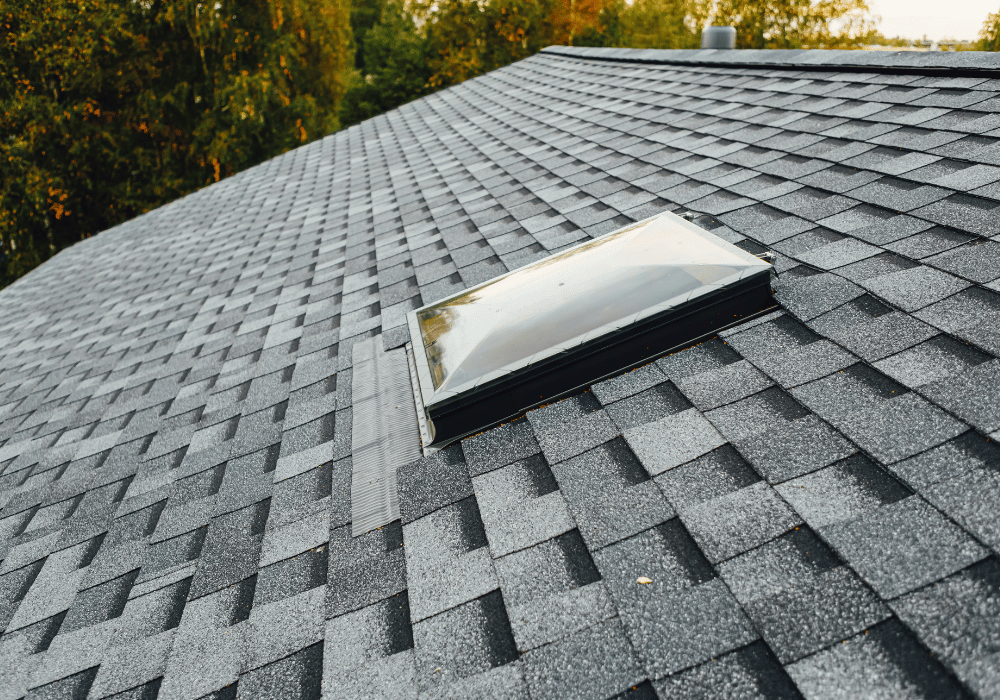
Plan for Professional Maintenance
Lastly, consider scheduling regular professional maintenance for your roof. Experienced roofing contractors can assess your roof’s condition, perform necessary repairs, and provide recommendations to keep it in optimum shape. Having a professional check your roof annually or biannually can extend its life significantly. Roofing maintenance plans can vary depending on the local weather and season within your region.
Proper care and maintenance are essential to extend the life of your roof, protect your home, and avoid expensive repairs or replacements. By following theses tips, you can ensure that your roof remains durable and functional for many years to come. A little effort now can go a long way toward safeguarding one of your home’s most critical elements.
The Importance of Regular Roof Inspections and Maintenance
The roof is one of the most important parts of any building, shielding the interior from rain, wind, snow, and sunlight. Despite its vital purpose, the roof is often overlooked until noticeable problems arise. Regular roof inspections and maintenance are essential to preserve the integrity of the structure, enhance its longevity, and prevent costly repairs. This blog will explore why roof inspections are indispensable and provide insights into how routine maintenance can save you time and money while ensuring the safety of your property.
Why Are Regular Roof Inspections Important?
Early Problem Detection
Damage to a roof doesn’t occur overnight; it happens gradually over time due to wear and tear, severe weather conditions, or poor installation. However, not all damage is visible to the untrained eye. Small issues, like missing shingles, cracked tiles, or minor leaks, can go unnoticed initially but may escalate into much larger problems if not addressed. Regular roof inspections allow professionals to detect these issues early, minimizing the damage and avoiding significant expenses in the future.
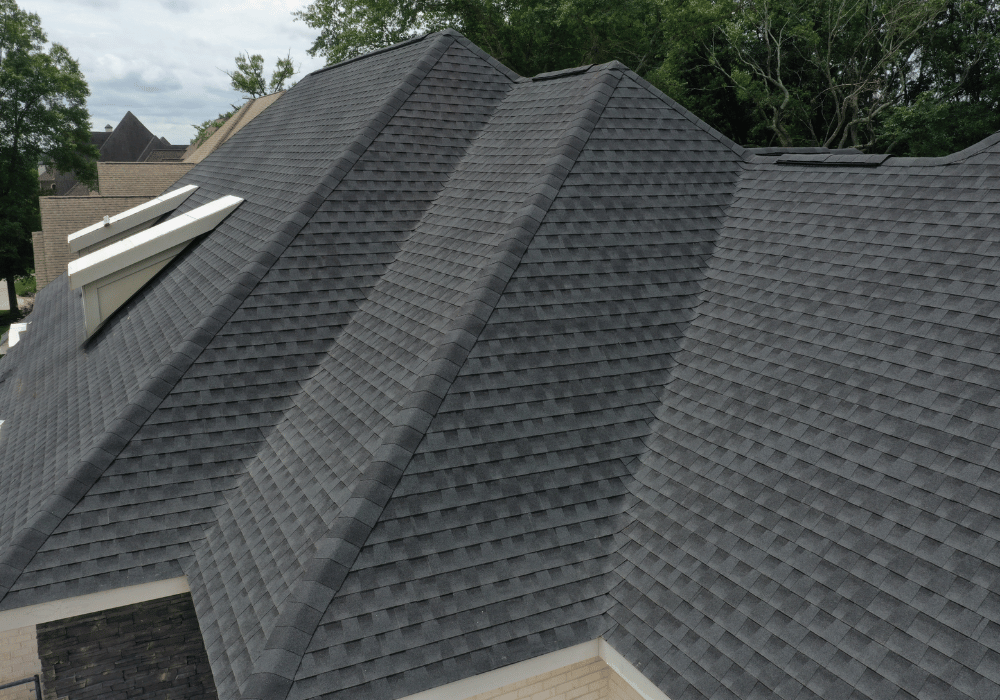
Prolonging Roof Lifespan
Every roof has an expected lifespan, but neglecting care and maintenance can cut that lifespan short. Regular inspections identify and address small problems that, if ignored, could drastically reduce the longevity of the roof. By staying proactive, property owners can extend the roof’s life and maximize their investment.
Preventing Structural Damage
A compromised roof can lead to water infiltration, which poses a serious threat to the structural integrity of your home or building. Over time, untreated roof leaks can damage insulation, walls, ceilings, and even the foundation of the property. Roof inspections help prevent such incidents by ensuring the roof’s waterproofing is intact and effective.
Ensuring Energy Efficiency
A properly maintained roof contributes significantly to the energy efficiency of a building. Damaged roofs can create gaps or allow moisture to seep in, which affects insulation and forces HVAC systems to work harder to maintain indoor temperatures. This results in higher energy bills. Regular inspections and maintenance ensure that the roof remains energy-efficient, keeping utility costs down.
Meeting Warranty Requirements
Many roofing manufacturers require proof of regular maintenance to uphold warranties. By scheduling routine inspections and keeping a detailed record of all maintenance activities, property owners can ensure that their warranty remains valid. This can be extremely helpful if unexpected issues arise during the warranty period.
Key Components of a Roof Inspection
When scheduling a professional roof inspection, it’s important to understand what it entails. Roofing contractors follow a thorough process to evaluate the overall health of your roof. A comprehensive roof inspection typically includes examining the following:
- Shingles or Roof Covering
Inspectors check for missing, loose, curled, or damaged shingles. They also look for signs of granule loss and general wear that may indicate aging or exposure to harsh weather.
- Flashing and Seals
Flashing and seals around vents, chimneys, and skylights are examined for cracks or deterioration. Proper sealing is essential to prevent water from entering the structure.
- Gutters and Drainage Systems
The effectiveness of gutters and downspouts is assessed to ensure there is no blockage or damage that could affect water drainage. Poor drainage can lead to water pooling on the roof.
- Signs of Moisture or Leaks
Water stains, mold, and mildew inside the attic or ceiling may indicate roof leaks. Inspectors use these signs to locate the source of water infiltration and recommend immediate repairs.
- Structural Integrity
The overall structure of the roof, including the decking, underlayment, and support system, is evaluated to ensure there are no weak or compromised areas.
- Ventilation
Proper roof ventilation helps regulate temperature and moisture levels in the attic. A lack of ventilation can cause issues like mold growth or ice dams during colder months.
The Benefits of Regular Roof Maintenance
Routine maintenance goes hand in hand with roof inspections. Both are crucial for preserving the longevity and performance of a roof. Here are some of the advantages of committing to regular roof maintenance:
Cost Savings
One of the most obvious advantages of proper maintenance is cost savings. Regular upkeep is far less expensive than emergency repairs or a complete roof replacement. Inspecting and addressing small issues, such as cleaning debris from gutters or replacing a few damaged shingles, prevents those issues from spiraling into major expenditures.
Enhancing Property Value
A well-maintained roof adds significant value to your property. Whether you plan to sell your home or lease a commercial space, buyers and tenants are far more likely to choose a building where the roof is in excellent condition. Taking care of your roof showcases your commitment to maintaining the property, which is a strong selling point.
Preventing Health Issues
A leaking roof can lead to mold and mildew growth, posing health risks to occupants, including respiratory problems and allergies. Regular maintenance ensures that leaks are promptly repaired, minimizing the chance of mold buildup.
Preparing for Extreme Weather
Hurricanes, snowstorms, and other extreme weather events can take a toll on roofs. Regular maintenance keeps your roof in top condition, ensuring it can withstand harsh weather with minimal damage.
Peace of Mind
Knowing that your roof is in excellent condition provides peace of mind. You can rest assured that your home or business is protected from the elements, freeing you from stress during heavy storms or unexpected weather changes.
How Often Should You Schedule Roof Inspections and Maintenance?
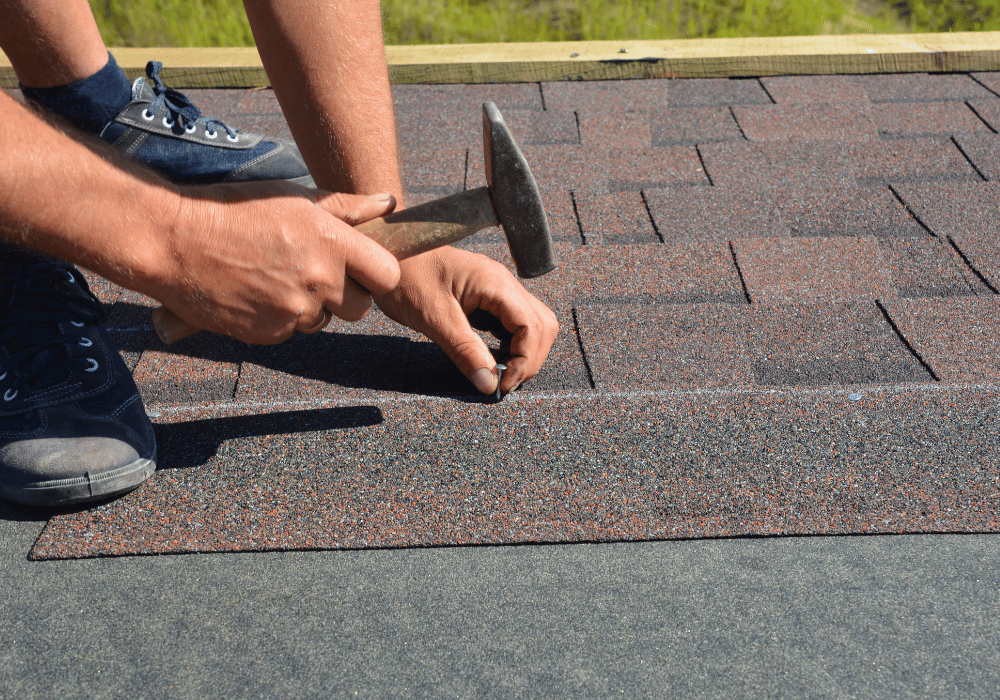
Roof inspections should typically be conducted twice a year — once in the spring and once in the fall. These periods are ideal because they precede and follow extreme weather seasons, allowing you to prepare for upcoming challenges and address any post-season issues.
Additionally, scheduling an inspection after major storms, heavy snowfall, or other severe weather events is highly recommended. For best results, have the inspections performed by a licensed and experienced roofing professional who knows what to look for and how to resolve potential issues effectively.
DIY Roof Maintenance Tips
While professional inspections and maintenance are crucial, property owners can take steps to care for their roof in between inspections:
- Keep Gutters Clear
Regularly clean gutters and downspouts to prevent blockages that could cause water to pool on the roof.
- Trim Overhanging Branches
Overhanging branches can damage shingles and increase the risk of debris accumulating on your roof. Trim any nearby trees to keep your roof clear.
- Inspect After Severe Weather
Check for visible signs of damage, such as missing shingles or cracked tiles, after storms or hail. Notify a roofing professional to assess the damage further.
- Remove Debris
Remove leaves, twigs, and other debris from the roof to prevent moisture buildup and the risk of mold or algae growth.
Trust the Experts for Your Roof’s Needs
Although DIY maintenance is helpful, it cannot replace the expertise of a professional roofing contractor. Experienced contractors have the tools, knowledge, and training to spot underlying issues that may not be readily apparent. They can provide tailored solutions to suit your roof’s specific needs, ensuring its durability and efficiency.
At Shockwave Roofing, we specialize in comprehensive roof inspections and maintenance services for residential and commercial properties in London, Ontario and surrounding areas. Our team of roofing professionals is dedicated to protecting your investment by extending the life of your roof
Benefits of Using a Professional Roofing Company
When it comes to maintaining or repairing your home’s roof, the importance of hiring a professional roofing company cannot be overstated. Your roof is your home’s first line of defense against the elements, protecting you, your family, and your belongings from weather-related damage. While it may be tempting to save money by attempting repairs or installation on your own, there are numerous advantages to enlisting the help of experienced professionals. Below, we explore the key benefits of working with a professional roofing company.
1. Expertise and Skill
Professional roofing companies employ highly trained and experienced roofers who have honed their skills over years of working in the field. Their expertise ensures that they can accurately diagnose issues, recommend appropriate solutions, and perform high-quality repairs or installations. Roofing is a specialized trade, and professionals are equipped with the technical knowledge and tools to handle even the most complex roofing projects. DIY attempts or hiring an inexperienced contractor could result in mistakes that lead to costly repairs or further damage down the line.
2. Access to High-Quality Materials
A reputable roofing company has access to premium-grade materials that may not be available to the general public. Professional roofers know which materials will best suit your specific project, whether it’s repairing shingles, replacing a metal roof, or installing durable tiles. By using high-quality materials, they can ensure the longevity, durability, and performance of your roof. Additionally, many professional roofing companies have established relationships with suppliers, allowing them to secure superior materials at a better cost.
3. Safety Standards and Protocols
Roofing can be a dangerous job, especially for those without the proper training or equipment. Climbing on roofs, handling heavy tools, and dealing with steep pitches and unstable surfaces pose significant risks. Professional roofing companies prioritize safety by adhering to strict safety standards and protocols. They use specialized safety equipment and are well-versed in managing potential hazards. Hiring professionals minimizes the risk of accidents, ensuring the protection of everyone involved.
4. Cost-Effectiveness
While hiring a professional roofing company may seem like a larger upfront investment, it often proves to be more cost-effective in the long run. Professionals get the job done right the first time, reducing the likelihood of errors that could lead to expensive repairs in the future. Additionally, many roofing companies offer warranties on their work, providing you with peace of mind and additional financial protection. Attempting to tackle roofing issues on your own or hiring an inexperienced contractor could result in short-term savings but lead to significant expenses over time.
5. Time Efficiency
Roofing projects, whether they involve repairs, replacements, or maintenance, can be time-intensive and labor-intensive. For a homeowner attempting a DIY job, it could take days or even weeks to complete the work. On the other hand, professional roofing companies bring teams of skilled workers, advanced tools, and streamlined processes to the table. Their efficiency allows them to complete your project in a fraction of the time it might take otherwise, letting you move on with minimal disruption to your daily life.
6. Inspection and Problem Identification
One of the critical advantages of hiring a professional roofing company is their ability to perform thorough inspections and identify underlying problems that may not be apparent to an untrained eye. During a routine inspection, roofing experts can spot issues like leaks, structural vulnerabilities, or areas prone to future damage. Early identification and intervention prevent more serious and costly problems from arising later on, saving you money and protecting your investment.
7. Warranty Options and Insurance Coverage
Professional roofing companies often offer warranties on their workmanship and the materials they use. This means that if any issues arise after the project is complete, they will address them at no extra cost to you, as per the warranty agreement. This assurance provides homeowners with added confidence in the quality of their roof. Furthermore, legitimate roofing companies carry liability insurance and workers’ compensation coverage to protect you from any financial liabilities that might arise during the course of the project.
8. Local Expertise and Knowledge
For homeowners, hiring a local roofing company provides additional benefits. Local professionals are familiar with weather patterns, climate conditions, and regional building codes, enabling them to recommend roofing materials and solutions tailored to your specific area. Their knowledge ensures that the roof is built to withstand local environmental challenges, providing long-term stability and durability.
9. Enhanced Property Value
The roof is one of the most prominent features of a home, greatly influencing its curb appeal and overall property value. A professionally installed or well-maintained roof can significantly enhance your home’s appearance and marketability. Potential buyers are often willing to pay a premium for properties with durable and visually appealing roofs, as they represent a reduced risk of future expenses. By hiring a professional roofing company, you ensure that your roof looks beautiful and performs well for years to come.
10. Compliance with Local Building Codes
Roofing projects are subject to local building codes and regulations that vary from area to area. Professional roofing companies are familiar with these codes and will ensure that the work is done in compliance with all relevant rules. Failing to meet these requirements can lead to fines, legal issues, or even the need to redo the project entirely. By hiring professionals, you can avoid the stress and hassle of navigating these complexities on your own.
11. Peace of Mind
Perhaps one of the most significant benefits of hiring a professional roofing company is the peace of mind it provides. You can rest easy knowing that experienced and qualified experts are handling one of the most vital components of your home. With professionals at the helm, you can focus on other priorities while trusting that your roof will be installed or repaired to the highest standards.
12. Help with Insurance Claims
When disaster strikes and your roof suffers damage due to storms or other unforeseen events, navigating the insurance claims process can be overwhelming. Many professional roofing companies have experience working with insurance providers and can assist you in documenting the damage and filing your claim. Their guidance ensures that you receive the compensation you’re entitled to and that the repair or replacement process moves forward without unnecessary delays.
Why Choosing the Right Roofing Company Matters
While the benefits of using a professional roofing company are clear, it’s equally important to choose the right company for your needs. Look for a contractor with a proven track record, positive customer reviews, proper certifications, and a commitment to quality. Doing your research and selecting a trustworthy provider ensures that your investment in your home’s roof will pay off for many years.
Why Choose Shockwave Roofing?
Shockwave Roofing stands out as one of the premier roofing companies in London, Ontario, offering unparalleled quality and service. With years of experience in the industry, the team at Shockwave Roofing is dedicated to providing expert craftsmanship and personalized solutions for every customer. From minor repairs to full roof replacements, they use only high-quality materials to ensure durability and long-lasting results.
What truly sets Shockwave Roofing apart is their commitment to customer satisfaction. They pride themselves on transparent communication, timely project completion, and competitive pricing. Additionally, their knowledgeable staff can assist you with insurance claims and detailed project planning, making what might be a stressful process straightforward and manageable. When you choose Shockwave Roofing, you’re investing in a company that values integrity, professionalism, and the protection of your home.
